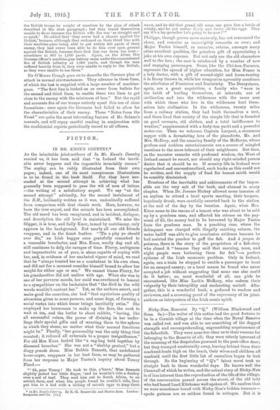THE IMPERIAL ARMY SERIES.* Trug excellent Army text-books edited by
Mr. E. John Solano —a well-known military expert, and the inventor of the various targets and accessories which have helped so greatly to increase the usefulness of instruction on miniature rifle- ranges—have been found of great service by many young officers. Indeed, the first issued of the seven volumes which now lie before us has already been reprinted no less than eight times and passed through four editions, although it was only published in September of last year. The series now covers the chief subjects with which the infantry officer is required to familiarize himself, and we need only say that the work is uniformly so well and efficiently done that we can heartily commend these volumes to the numerous subalterns on whom the present crisis has unexpectedly thrust the cares and responsibilities of a military career. All the volumes are written by competent officers of the Regular Army, under the general editorship of Mr. Solano, and they are throughout closely based on the official training manuals. General Sir O'Moore Creagh, in the valuable " Notes on Experience Gained at the Front" in the present war which he and other General Officers contribute to these volumes, points out that these manuals—the careful product of generations of revision—have proved themselves to be adequate. " The broad principles upon which the training of the British Army has been based are described by a General Officer as being sound, and the need of paying strict attention to them in carrying out training is emphasized by him." These principles have accordingly been followed with meticulous ears in the " Imperial Army Series," the authors of which expand and illustrate them more fully than the official manuals have hitherto done. Returning to the notes which Sir O'Moore Creagh has written for the volume on Musketry, we may quote his very interesting comparison between the shooting of German and English troops, as tested in actual warfare. He writes as follows :- " German 2fusketry. (1) The Germans consider it unnecessary to teach men to fire at distances beyond 400 metres (about 435 yards). Their plan of infantry attack is devised to get within this range without opening fire. Accordingly, judging distance is practised by officers only, and no attention is devoted to the indication of targets, concentration of fire, or to fire direction and control generally, as practised in the British Army. To concentrate the fire of a platoon or company on one spot at 1,000 yards range was considered by Germans to be a waste of ammunition, Their training seems to have been limited to independent firing by battalions on large areas of ground. (ii) Only some of their men were practised in rapid firing, which averaged eight or nine rounds a minute, as against the fifteen well-aimed shots a minute which British troops are trained to deliver in rapid firing. In this respect it may be mentioned that the straight bolt of the German rifle is not so easy to work as the bolt of the British rifle, nor is its clip so easy to put in. When put to the test of war, the musketry of the German infantry is characterized by British officers as poor and lament- able.'
British Musketry, On the other hand, the German officer referred to in the footnote below described British musketry under the test of war as marvellous,' and in doing so expressed the views generally held in the German Army as the result of experience. He states that the. Germans had counted on being able to rush 'IP Drill and Field Training ; Musketry; Machine Gun Training ; Field Entrenchments; Signalling ; Physical Training (Sanior Course) ; Campo, Billota, Cooking, Ceremonial. Written by Officers of the Regular Army and Edited by E. John Solano, ' "Imperial Army Series." Lendoul Jelin Huriay. [Is. net each.] the British troops by weight, of numbers by the plan of attack described in the next paragraph; but they found themselves unable to do so because the British rifle fire was ° so straight and so quick.' He added that they never had a chance against the British,' because, although they reckoned on their third lino with their machine-guns being able to get within 400 yards of their enemy, they had never been able to do this over open ground against the British, because their first line was down too soon— sometimes at 800 to 1,000 yards. Again, on the Aisne, this German officer's machine-gun battery came under the concentrated fire of British infantry at 1,000 yards, and though• his men suffered heavily from it, they were unable to reply to the British, as they were tumble- to see them."
Sir O'Idoore Creagh goes on to describe the German plan of attack in normal circumstances. They advance in three lines, of which the last is supplied with a large number of machine- guns. "The first line is looked on as cover from bullets for the second and third lines, to enable these two lines to get close to the enemy with the minimum of loss," But the rapid and accurate fire of our troops entirely upset this use of close formations : once again the Germans had failed to allow for the characteristics of their enemy. These "Notes from the Front" are quite the most interesting feature of Mr. Solano's manuals, and will repay careful reading in conjunction with the confidential reports periodically issued to all officers.



































 Previous page
Previous page